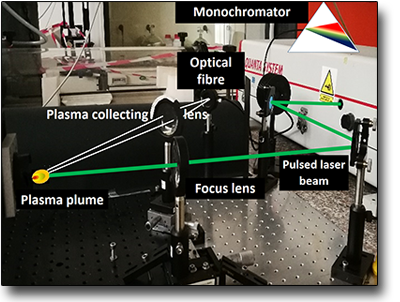
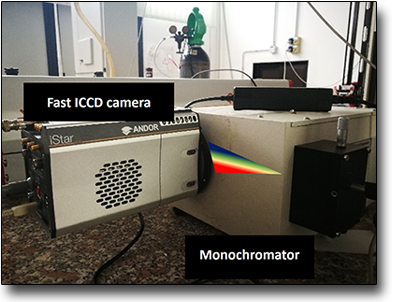
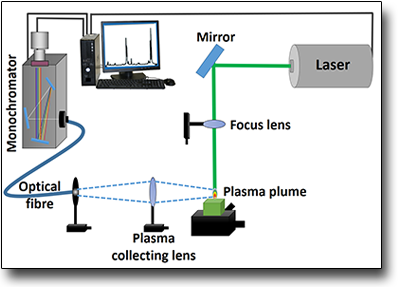
TECHNICAL SPECIFICATIONS
- Spectra Physics Ti:Sa “fs” Laser
Spitfire Pro - Regenerative Amplifier (120 fs; 1kHz; 4 mJ @ 800 nm; SH: 1.5 mJ @ 400 nm) - Quanta System Nd:YAG “ns” Laser
Prototype (7 ns; 10 Hz; 100 mJ @ 532 nm) - Time resolved spectroscopy and imaging
- Andor iStar “Inductively Charge Couple Device – ICCD” camera (t ≥ 2 ns; Spectral range = 250-900 nm, Pixeldim = 13 μm x 13 μm)
- Monochromator ARC SpectraPro 300i (Spectral range = 200-1000 nm; ʎ/Δʎ = 10000)
AVAILABLE TECHNIQUES
- Characterization of laser induced plasmas features and temporal evolution of them
- acquisition of the emission spectra
- determination of the electronic density by Stark broadening
- outline the operating conditions that fulfill the LTE conditions
- definition of the excitation temperatures
- Analysis of the samples under study
- building-up of calibration lines if are available several standards having a matrix comparable with that of the sample to be analyzed (quantitative analysis)
- use of other procedures (e.g. inverse calibration free) for semi-quantitative analyses .
- The LIBS activities are carried out in collaboration with the Physical-Chemistry Laser Laboratory of the University of Basilicata which expands the offer by the availability of other experimental equipments and techniques for materials’ characterization (e.g. μ-Raman, XPS, XRD).
SAMPLES
-
It is suitable for any solid, preferably flat, for which it is available at least a standard with known composition and having same matrix of the sample under investigation.
-
Sample lateral size 5 mm x5 mm (minimum) - 30 mm x 30 mm (maximum).
USED FOR
-
analysis of metal alloys
-
analysis of archaeological artifacts
-
stratigraphic analysis
-
compositional analysis of solids in the (x, y) plane with spatial resolution up to a few μm
-
fingerprint spectra of polymeric compounds
CASE STUDIES
Experimental remarks
The emission spectrum of the plasmas generated by pulsed lasers shows a temporal evolution formed, initially, by Bremsstrahlung and ion-electron recombination continuum. This emission quenches rapidly over time, allowing the signals of electronically excited species to emerge after the first 0.1-1 μs. The features of the excited species emission are related to the composition of the sample under examination. However, the various signal intensities can be linked to the concentrations of the single species only if the following conditions: LTE, homogeneity and "thin" plasma, are fulfilled. These requirements can be determined for each type of sample by varying the delay and acquisition times of the emission’s spectra. It follows that the LIBS technique depends strongly on the matrix of the sample to be analyzed and on the need of having detector with high time resolutions so that fast detectors such as ICCD camera are employed.ossono essere correlate alle concentrazioni delle singole specie solo riuscendo a soddisfare le condizioni di LTE, omogeneità e plasma “sottile” che devono essere verificate per ogni tipologia di campione variando i tempi di ritardo e di acquisizione degli spettri di emissione. Queste condizioni rendono la tecnica dipendente dalla matrice del campione in analisi e dalla risoluzione temporale del rivelatore per cui è necessario l’uso di rivelatori veloci (e.g. ICCD) che hanno risoluzioni del ns.
See: David W., Hahn et al. Appl. Spect. 64, 335A (2010)
DOI: 10.1366/000370210793561691
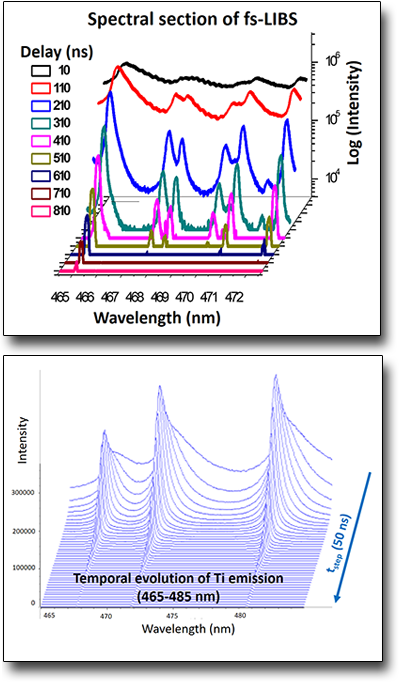
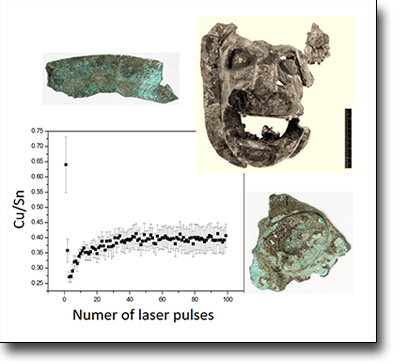
Compositional and stratigraphic analyses
After having determined the most suitable acquisition time intervals (delay and gate) of the emitting plasma spectrum, it is possible to carry out compositional analyses of the materials either through the known method of Calibration Free and its following upgrades or, if standards with a matrix comparable to that of the material under analysis are available, by building-up calibration graphs. The analyses processing time can be limited to few seconds per each single sampling point up to only few minutes for semi-quantitative compositional analyses. Due to both the processing speed which can be well exploited for comparative analyses and the lack of sample preparation, LIBS is widely used in archeometry for dating and classifying archaeological artifacts. Using fs laser pulses stratigraphic analyses with good spatial resolution (500 nm / pulse) can be performed. These pulses are even extremely advantageous for limiting both the damage of the surface of the analyzed material and the involvement of thermal effects which can lead to the occurrence, within the sample, of elemental interdiffusion interfering phenomena..
See: Angela, De Bonis et al., Appl. Surf. Sci. 302, 275 (2014)
DOI: 10.1016/j.apsusc.2013.10.127
Identification of the species in Polypropylene (PP) materials deriving from automotive production wastes and end-of-life vehicles (ELVs)
A qualitative elemental analysis of LIBS spectra conducted on virgin plastic materials, production wastes and end of life vehicles (ELVs) deriving from the automotive industry, allowed us to distinguish the species in different samples characterizing the polymer matrix and the mineral fillers commonly enriching polymers. From the acquired LIBS spectra it was possible to verify the presence of the main elements, such as: Magnesium (Mg) and Silicon (Si). In addition to these, we have also been able to ascertain the presence of species such as: Aluminum (Al) and Sodium (Na) related mostly to the impurities that are commonly found in natural talc. .
As far as the polymer matrix is concerned, the characteristic LIBS signals have been traced: the Swan bands (Carbon dimers in the excited state) around 470 and 510 nm, the CN bands (generated by the interaction of the laser beam with the matrix plastic in air) and those of Carbon around 250 nm.
Once the typical talc signals found in all the analyzed samples were excluded, the comparison of the spectrum of a model isotactic PP with those of the virgin raw materials (PP bumpers, PP defroster, PP dashboard), production wastes (PP waste) and ELV samples (ELV1 PP, ELV2 PP), has easily highlighted the presence of species deriving from impurities (especially in the waste material and in PP ELV) and /or from additives both of an organic and inorganic nature that typically characterize the formulation of almost all the plastic products on the market. In this regard, we can highlight the characteristic fingerprint of Titanium (Ti) clearly identified within some samples analyzed..
Contact: Ambra Guarnaccio -
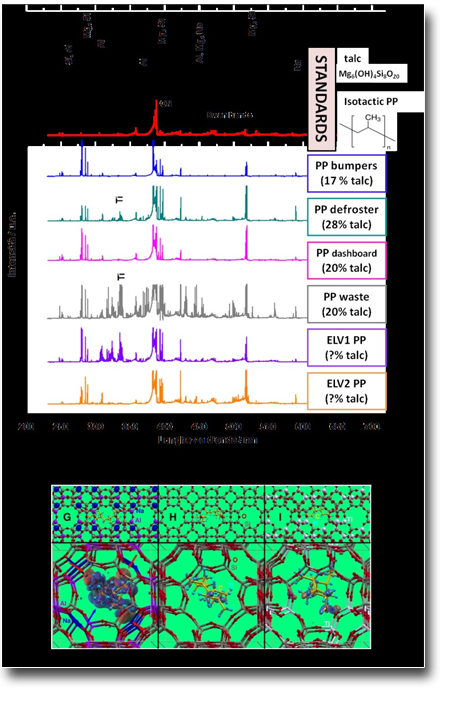

 English (UK)
English (UK)  Italiano (Italia)
Italiano (Italia)